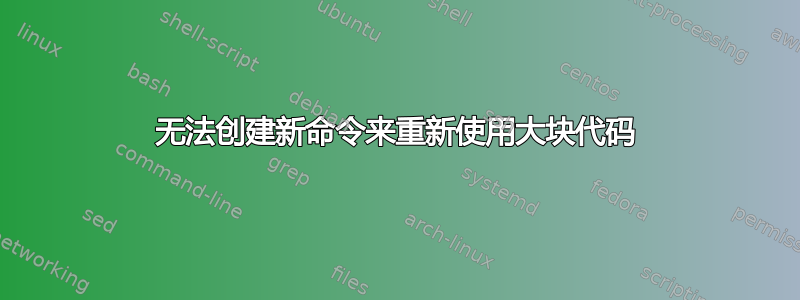
我是 LaTeX 新手。尝试创建一个可重复使用的命令来绘制卡诺表,但允许我随意为其提供更多内容。以下代码对我来说不起作用,失败并显示“未定义的控制序列”,但我不知道为什么,也无法让它工作,尝试了在互联网上找到的不同解决方案,包括一些使用xparse包的解决方案
\documentclass[12pt]{article}
\usepackage[utf8]{inputenc}
\usepackage{amsmath}
\usepackage{amsfonts}
\usepackage{amssymb}
\usepackage{lmodern}
\usepackage[left=2cm,right=2cm,top=2cm,bottom=2cm]{geometry}
\usepackage{tikz}
\usepackage{circuitikz}
\usepackage{multicol}
\usetikzlibrary{calc}
\usetikzlibrary{positioning}
\usetikzlibrary{matrix}
\pgfdeclarelayer{background}
\pgfsetlayers{background,main}
\newcommand{\karnaugh}[1][]{%
\begin{center}%
\begin{tikzpicture}
\matrix (karnaugh) [matrix of math nodes] {%
0 & 0 & 0 & 1 \\%
0 & 0 & 0 & 1 \\%
- & - & - & - \\%
0 & 1 & 0 & 0 \\%
} ;
\foreach \i/\bits in {1/00,2/01,3/11,4/10} {
\node [left = 1.2cm of karnaugh-\i-1] (x43-\i) {$\bits$} ;
\node [above = 0.7cm of karnaugh-1-\i] (x21-\i) {$\bits$} ;
}
\node [above = .2cm of x43-1] (x4x3) {$x_4 x_3$} ;
\node [left = .2cm of x21-1] (x2x1) {$x_2 x_1$} ;
\draw ($(x4x3.north -| karnaugh.west) + ( -0.75mm, 6.00mm)$)
-- ($(karnaugh.south -| karnaugh.west) + ( -0.75mm, 0 )$)
($(x2x1.west |- karnaugh.north) + (-10.00mm, 0.40mm)$)
-- ($(karnaugh.east |- karnaugh.north) + ( 0 , 0.40mm)$)
($(karnaugh.north west) + ( -0.75mm, 0.40mm)$)
-- ($(x4x3.north -| x2x1.west) + (-10.00mm, 6.00mm)$);
#1
\end{tikzpicture}%
\end{center}%
}
\begin{document}
Test
\karnaugh
\karnaugh[
\begin{pgfonlayer}{background}
\begin{scope}[opacity=.5]
\fill[red](karnaugh-1-4.north west) rectangle (karnaugh-2-4.south east) ;
\fill[blue](karnaugh-3-2.north west) rectangle (karnaugh-4-2.south east) ;
\end{scope}
\end{pgfonlayer}
]
\end{document}
答案1
两个问题:
- 您需要用括号括住可选参数,因为它包含另一个可选参数。
- 您需要这样做,
ampersand replacement因为&TikZ 矩阵有望找到该方法。
代码:
\documentclass[12pt]{article}
\usepackage[utf8]{inputenc}
\usepackage{amsmath}
\usepackage{amsfonts}
\usepackage{amssymb}
\usepackage{lmodern}
\usepackage[left=2cm,right=2cm,top=2cm,bottom=2cm]{geometry}
\usepackage{tikz}
\usepackage{circuitikz}
\usepackage{multicol}
\usetikzlibrary{calc}
\usetikzlibrary{positioning}
\usetikzlibrary{matrix}
\pgfdeclarelayer{background}
\pgfsetlayers{background,main}
\newcommand{\karnaugh}[1][]{%
\begin{center}%
\begin{tikzpicture}[ampersand replacement=\&]
\matrix (karnaugh) [matrix of math nodes] {%
0 \& 0 \& 0 \& 1 \\%
0 \& 0 \& 0 \& 1 \\%
- \& - \& - \& - \\%
0 \& 1 \& 0 \& 0 \\%
} ;
\foreach \i/\bits in {1/00,2/01,3/11,4/10} {
\node [left = 1.2cm of karnaugh-\i-1] (x43-\i) {$\bits$} ;
\node [above = 0.7cm of karnaugh-1-\i] (x21-\i) {$\bits$} ;
}
\node [above = .2cm of x43-1] (x4x3) {$x_4 x_3$} ;
\node [left = .2cm of x21-1] (x2x1) {$x_2 x_1$} ;
\draw ($(x4x3.north -| karnaugh.west) + ( -0.75mm, 6.00mm)$)
-- ($(karnaugh.south -| karnaugh.west) + ( -0.75mm, 0 )$)
($(x2x1.west |- karnaugh.north) + (-10.00mm, 0.40mm)$)
-- ($(karnaugh.east |- karnaugh.north) + ( 0 , 0.40mm)$)
($(karnaugh.north west) + ( -0.75mm, 0.40mm)$)
-- ($(x4x3.north -| x2x1.west) + (-10.00mm, 6.00mm)$);
#1
\end{tikzpicture}%
\end{center}%
}
\begin{document}
Test
\karnaugh
\karnaugh[{
\begin{pgfonlayer}{background}
\begin{scope}[opacity=.5]
\fill[red](karnaugh-1-4.north west) rectangle (karnaugh-2-4.south east) ;
\fill[blue](karnaugh-3-2.north west) rectangle (karnaugh-4-2.south east) ;
\end{scope}
\end{pgfonlayer}
}]
\end{document}
您可以考虑使用像kvmap或karnaugh这样的允许可寻址矩阵节点的包并尝试简化绘制卡诺图的工作流程。



